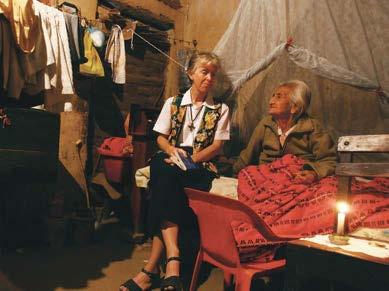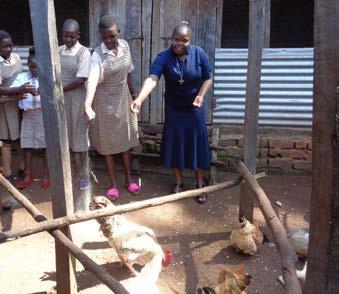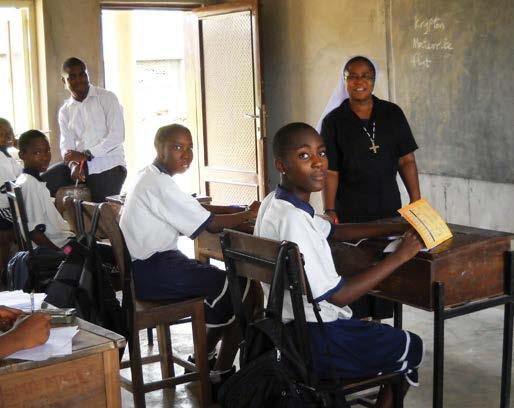CROSS CURRENTS

20 YEARS AT THE UNITED NATIONS: ADVOCATING FOR THE MOST VULNERABLE ON THE WORLD STAGE

SPRING 2022 VOLUME 18 ISSUE 1
CROSS CURRENTS
Sisters of Notre Dame de Namur change lives by making known God’s goodness with you.
Throughout the world, we are committed to education. We take our stand with those living in poverty, especially women and children in the most abandoned places. Cross Currents is published two times a year for friends of the Sisters of Notre Dame de Namur by the Ohio Province Development Office.
We invite reader responses on the content of this publication or on the work of the Sisters of Notre Dame de Namur. Comments may be submitted to Kevin Manley, Director of Development, at kmanley@ ohsnd.org.
Sisters of Notre Dame de Namur Ohio Province 701 E. Columbia Avenue Cincinnati, OH 45215
513-761-7636 / 513-761-6159 (fax) www.sndohio.org
Leadership Team:
Sister Kathleen Harmon, SNDdeN, Provincial
Sister Donna Marie Jurick, SNDdeN
Sister Patricia Loome, SNDdeN
Publisher: Kevin Manley kmanley@ohsnd.org
513-679-8117
Writer: Joe Foley
Editor: Angela Weisgerber
Photography:
Cover: courtesy of Notre Dame Mission Volunteers
Page 4: Pilar Olivares
Page 8: courtesy of Keith Hanley
Page 9 (top right): Mary Dee Donovan
Back cover top left: Jeff Gardner, Optasia Productions LLC
All others by local and international Sisters and staff
COVER:

AS WIDE AS THE WORLD
St. Julie asked the Sisters of Notre Dame de Namur to have hearts as wide as the world. And so they have done. Literally.
They have loved one another and have loved those most near them. But they have as well ventured forth into the unknown to love even farther.
They came in a sailing ship across a mighty ocean to America’s shores, knowing no one and realizing they might never again see their native lands.
Likewise they traveled to Africa, and to Asia, and to Latin America.
All for love. All to love beyond the comfort zones. All to love as Christ loved.
I imagine even St. Julie would be surprised to see how far afield her Sisters have been flung (or have flung themselves), and how they have carried forth the mission of giving people what they need for life, and of showing by their own example the goodness of God.
In this issue you’ll see how today’s Sisters work to improve lives on a macro, policy scale through the United Nations, while simultaneously working to improve lives one person at a time — whether that person be a high school student studying STEM in America or a young mother in the Democratic Republic of Congo seeking clean water for her children.
The Sisters' work and indeed their hearts have become as wide as the world!
THE CONSCIENCE
OF THE UNITED NATIONS
And it’s true at the United Nations, where Sister Joan, twenty years ago, became the Sisters’ first non-governmental organization (NGO) representative, serving eight years in an advisory role to the world body’s Economic and Social Council.

“Saint Julie,” says Sister Joan, “was loving to others around her. She was a person of relationship. She responded with patience. And that’s how Sisters relate to people around the world. It’s human
Children of Notre Dame Bakery employees in Les Cayes, Haiti, receive scholarships to attend school. CONTINUED
KEVIN MANLEY Director of Development
 SISTERS OF NOTRE DAME DE NAMUR
SISTERS OF NOTRE DAME DE NAMUR
CROSS CURRENTS
Spring 2022 | Vol. 18/Issue 1
ON PAGE 4
Sisters get along.
They work in the trenches, they discern, they discuss, they find what Sister of Notre Dame de Namur Joan Burke calls “a common mind.”
It’s true in Cincinnati, in Africa, in Latin America.
3
At the United Nations, Sister of Notre Dame de Namur Joan Burke, with David Stang, brother of martyred Sister Dorothy Stang, accept her posthumously awarded United Nations Prize in the Field of Human Rights.
relations writ large. It’s how we have to sort things out.”
President Franklin Roosevelt, in the earliest days of the United Nations (U.N.), insisted that in addition to governments, non-governmental organizations (NGOs) have a voice. Included in these NGOs today are congregations of women and men religious. In addition to a moral perspective, they bring with them a vast and worldwide network of sisters, brothers, priests and lay people through which information can move in real time, and in both directions. These networks can inform the U.N., and its government delegates of developing trends, worsening or improving conditions, injustices, destabilizing developments, popular sentiments, etc., and can also communicate the priorities of the U.N., and in some cases actualize those priorities, not only through their own communications but through the churches, schools, hospitals, social service agencies and many other ministries in which they are intimately involved.
“We don’t see issues in terms of boundaries. We see issues in the faces of people. We see challenges frequently before governments are even aware of them.” Sister Joan cites the emergence of HIV / AIDS in the Democratic Republic of Congo, where she previously worked. “Sisters knew this first,” she says. “They (officials at the United Nations) know the NGOs are already scrambling before they even know about things.”
In many ways Sister Joan was a natural choice for the Sisters’ first representative. By her mid-twenties, she was mission secretary for the congregation, based in Rome but traveling regularly to the five continents where Sisters of Notre Dame de Namur live and work. She had work experience not only in the developed world, coordinating the school lunch program for the Archdiocese of San Francisco, but in the developing world, working with people who are poor in Nigeria and the Democratic Republic of Congo.
She also brought to the United Nations, as do all representatives of Catholic religious congregations, a firm knowledge of Catholic social tradition. This, she says, gave her and other congregational representatives a leg up when responding to situations
involving human rights, care of the earth and other moral issues. “We see an issue immediately from the perspective of the Gospels,” she says. “We can come up with responses so quickly because Catholic social tradition is a part of our frame of reference.”
Government delegates, on the other hand, as representatives (and employees) of individual governments, have to report to those governments and have to toe the line in terms of their positions and votes.
“Unlike them,” says Sister Joan, “we’re life members [of our respective congregations]. We don’t have to get approval. We look at things from a moral perspective. That’s paramount. Governments can’t do that.
ON THE RIGHT
Women access clean water at the village pump after the Sisters’ water system was upgraded in Kitenda, Democratic Republic of Congo.

“We don’t see issues in terms of boundaries. We see issues in the faces of people. We see challenges frequently before governments are even aware of them.”
"We're only there because we have something to say. We're really there because of our experience on the ground."
Kofi Annan, a former United Nations Secretary-General, recognizing this impartiality, once called NGOs, including religious congregations, the “conscience of the U.N.”
A United Nations within a United Nations
The Sisters of Notre Dame de Namur, with Sisters in 14
countries, are already a ‘united nations’ of sorts. They minister under the direction of a multinational Leadership Team based in Rome (see page 9 for the most recently elected team); they confer often and at length across borders on issues facing those they serve, such as gender discrimination, illiteracy and a lack of clean water; and they work toward a more equitable distribution of resources among their richer provinces in the developed north and those provinces ministering in the still developing world in Africa and Latin America. This distribution of resources is done not in “the trap of giver-receiver,” according to Sister Joan, which creates resentment and dependency, but in a manner that recognizes interdependence and common cause.
The Sisters, also by their example, show the effectiveness and accomplishments of women in places where women and girls have historically been denied opportunities in education, employment and basic human rights, and where few women professional role models exist. And they’ve done this not only at the policy level, or position-paper


level, but, as Sister Joan calls it, at the ‘micro-level’ of cross-cultural community living where Sisters work side-by-side not only with other Sisters but with lay people at the bottom of the socio-economic ladder.
This last practice has, in particular, won the respect of official nationstate delegates in that the great preponderance of these delegates have no such real-world and
ABOVE
hands-on experience, or personal connections to those who often most feel the brunt of
5 4 SISTERS OF NOTRE DAME DE NAMUR
SISTER JOAN BURKE
While serving in pastoral ministry in Tambogrande, Peru, Sister Meg Walsh visits and prays with a parishioner.
CONTINUED ON PAGE 6
Like St. Julie, Sisters of Notre Dame de Namur in Tanke, Nigeria provide Catholic education for girls.
inequity, social and environmental injustice, and income inequality.
“Governments know what we are doing, we are doing because of our convictions and our knowledge. They know they can’t contradict what we’re saying and they know we’re not here to proselytize,” says Sister Joan. “[Sister] Dorothy Stang,” she says, “was an especially catalyzing event for them. It made them realize the value of people working on the ground, and paying the price.”

An Expanded Influence
When Sister Joan began her work at the United Nations she gave a lot of thought not only to what the Sisters could bring to the U.N., but what the U.N. could bring to the Sisters. She concluded that by working collaboratively with the United Nations, the Sisters would gain a better awareness of the similarities and interconnectedness of needs of people who are poor; and a deeper, more evidenced-based understanding of the urgency of certain issues bearing down upon them, such as environmental degradation and an erosion of the rule of law. Participation also gave the Sisters — as with other NGOs — a better, more practical understanding of the obstacles faced by self-interested governments, and with that knowledge, an ability to craft creative solutions appreciating the needs of all interested parties.
Participation also built solidarity with other organizations and individuals who though they might be of different religious and philosophical traditions, nevertheless share the same goal of uplifting people who are marginalized. This solidarity stands to create networking which in turn further establishes solidarity, resulting in more good being done for greater numbers of people.
On this last point, Sister Joan says, “There is an opportunity to read the ‘signs of the times’ that we would not have otherwise.”
“It’s so hard for Sisters on the ground,” she says, “because they’re working so hard, and because everything is so immediate, to see how what they are doing can bring change to the world.”
But by linking their work, says Sister Joan, with others around the world, and through advocating on the world stage for the very work they are doing locally, the commonality of need and the enormity of need can be appreciated and conceivably addressed.

“Advocacy is really going to be what is responsive to people we’re trying to help. Otherwise our influence is very limited to the kids we’re working with, and maybe their parents.”
This type of broader more elevated advocacy, for the Sisters, began in the 1960s and 1970s, according to Sister Joan.
“It’s then that we became more justice oriented.”
“But it’s shifting policy, that’s what it’s all about. Just us, we are a drop in the bucket. But if we can change the discourse, if we can change mindsets, it creates openings for deeper social change.”
And deeper social change is what Sister Joan is about. “Social justice is a constituent part of the Gospel,” she says. “And as a person of faith, I believe the spirit is working across the world.”
That same spirit followed by Saint Julie. And Saint Julie, Sister Joan says, would have no problem in the United Nations. She would move easily there. And she’d say, says Sister Joan, “Speak up for the will of the people. Persevere!”

7 6 CROSS CURRENTS SISTERS OF NOTRE DAME DE NAMUR
After graduating with a master’s degree in Education from Xavier University in Cincinnati, OH, Sister Eucharia returned to Nigeria to teach in Notre Dame schools there.
ABOVE
Sister Dorothy Stang fought for the human rights of sustainable farmers in the Brazilian Amazon before she was martyred for her faith in 2005.
Sister Susan feeds chickens with students of the Sisters of Notre Dame de Namur Outreach Program in Malava, Kenya.
ADOPT-A-SISTER ON HOLD DURING PANDEMIC

NEWSBRIEFS
PHOTOVOLTAIC LEARNING LAB ADDS WATER PURIFICATION

The Sisters of Notre Dame de Namur Photovoltaic Learning Lab in Cincinnati is moving into Phase Two of its mission to assist in the provision of electricity and clean water to the Sisters’ African missions, schools and hospitals while building the science, technology, engineering and mathematics skills (STEM skills) of students in the United States. Phase Two, with a goal of water purification, will build on the lab’s first phase of developing electrical power generation through photovoltaic systems, power which will in turn be used to clean water.
According to Keith Hanley, Learning Lab lead engineer, two steel water treatment modules are now under
fabrication with delivery to the lab scheduled for spring. The first module will serve as an intake and will strain raw unpurified water, with the second module then filtering the water for potability. Piping for the modules and the larger system is also under fabrication.
“This will allow students to run experiments in water treatment similar to the systems we have in Africa,” says Hanley, “and to test various filters.”
The treatment modules are being developed in conjunction with the Cincinnati chapter of Engineers Without Borders, which includes universities in the Greater Cincinnati area.
NEW CONGREGATIONAL LEADERSHIP
The premise of the five-year-old Learning Lab is to test or preflight technologies for electricity generation and water treatment, and combinations of these technologies, taking into account African conditions related to climate, affordability, staffing, supply chains, water contaminants, etc. Based on these tests, conducted by students on a small scale, strategies and technologies can be employed (or not employed) on a much larger scale in the Sisters’ African ministries.
To date, students of Mount Notre Dame High School in Cincinnati and Chaminade Julienne Catholic High School in Dayton have participated in the Learning Lab’s operations.
The Sisters of Notre Dame de Namur worldwide congregation, during its 18th General Chapter, elected new leadership for the coming six-year term. The five-member team will include Sisters Lorraine Connell and Mary Johnson f rom the United States, Sister Evalyne Aseyo from Kenya, Sister Amarachi Grace Ezeonu from Nigeria and Sister Miriam Montero Bereche from the Peru-Nicaragua Province. Sister Mary Johnson will succeed Sister Teresita Weind, of the Ohio Province, as General Moderator. The new team will begin its term in Rome, Italy in early 2022.
Since the founding of the Sisters of Notre Dame de Namur, the congregation’s leader has worn a very special medallion. It is one of three that was struck in 1804 to commemorate vows taken by the first three Sisters of Notre Dame de Namur –Julie Billiart, Françoise Blin de Bourdon and Catherine Duchatel.

The Sisters of Notre Dame de Namur Adopta -Sister Program, which in years past teamed up 25 to 30 Sisters with approximately 100 students from Cincinnati’s all-girl Mount Notre Dame High School, has been paused because of the ongoing pandemic. Through Adopt-a-Sister, the most popular extracurricular activity of the school, girls met with their adopted Sisters at least once a month, with the girls setting the format for activities, which included meals, outings and watching sports events together. (Mount Notre Dame High School is adjacent to the Sisters’ convent.) Relationships fostered through Adopt-a-Sister often continued for years, even after graduation. According to Sister Ruthann Bedinghaus, who manages the program, a limited version of the program is continuing through correspondence and a gift program.
LIVE THE GOOD & UPSPRING
In October 2021, Sisters and Province Staff in Cincinnati, collected personal care items for UpSpring, a regional nonprofit serving the educational needs of children and youth experiencing homelessness. Sisters prepared 119 hygiene kits with the items and provided a large box of supplies to make many more.
"We are so grateful for these donations. With students now back in-person, school personnel are now better able to identify students as homeless and as a result, we are receiving more requests for essential items than ever. These hygiene kits are extremely helpful and needed for us to continue to serve children experiencing homelessness.”
Maurice B. Stewart, UpSpring Program Director
9 8 SISTERS OF NOTRE DAME DE NAMUR
ON THE RIGHT
L to R: Learning Lab Lead Engineer Keith Hanley, along with Cincinnati chapter of Engineers Without Borders members and volunteers Tim Galieti, Gordon Miller and Sarah Hunt.
ABOVE Sister Patricia Rooks meets with her Mount Notre Dame High School Adopt-A-Sister group in 2019.
MEDALLIAN PHOTO ABOVE
CROSS CURRENTS

WE WILL ALWAYS REMEMBER
SISTER MARIE ANDARY SND deN
Formerly Agnes Gertrude • October 31, 1923 – September 8, 2021

In 1946, Sister Marie began her career teaching 2nd through 8th graders at schools in Ohio and Illinois. After 23 years in formal education, Sister Marie began a 21-year career in religious education in the Archdiocese of Cincinnati, using her organizational and creative skills to serve the 25-parish Hamilton Deanery and St. Charles Borromeo Parish in Dayton. In 1993, she joined the Alliance for Work Based Education program at the University of Dayton that helped adults work toward their GED and gain computer skills. In 2006, Sister Marie returned to Mount Notre Dame and served more than 10 years as receptionist at the Province Office. Always in her heart were her family and Lebanese roots.
SISTER DOROTHY BEACH SND deN
Formerly Francis Mary • July 25, 1921 – October 12, 2021
Upon graduating from Trinity College, and coming from a military family, Sister Dorothy enlisted in the female section of the U.S. Naval Reserve known as WAVES in 1943 to help the war effort. When the war ended, she entered with the Sisters of Notre Dame de Namur and taught high school for two years. Beginning in 1950, Sister Dorothy spent the next 35 years at the Trinity College Library where she became head librarian in 1972. In 1985, Sister Dorothy went to Rome as librarian for the North American College Graduate Department where U.S. diocesan priests studied for advanced degrees. After six years, she returned to Maryland and served as the province archivist, before returning full-circle to Trinity College as a library volunteer.
SISTER NATALIE SCIBILIA SND deN
Formerly Ann Christine • November 24, 1927 – October 19, 2021
For the first 25 years of Sister Natalie’s teaching career, she focused on first and second graders bringing to her ministry a strong work ethic, organizational skills, joy of life and deep belief in God’s goodness. The rest of her 45 years of teaching were devoted to teaching Social Studies, Language Arts, Drama and Speech to the intermediate grades and teaching religious education classes to young parishioners who attended public school. Sister Natalie answered a need for internal ministry and served seven years as secretary for the Maryland Province before returning to teaching for ten more years. Her final 13 years of active ministry were spent as part of the province staff.
We are mindful that we stand on the shoulders of those who have come before us. For complete obituaries, please visit sndohio.org
SISTER MARIANNE BOBOWSKI SND deN
Formerly Robert Mary • March 4, 1937 – December 5, 2021
Sister Marianne began 43 years of teaching in 1957 and taught every grade from one through six. In 1963, the intermediate grades became her focus with Social Studies and Language Arts as her specialties. She also took additional courses in guidance and counseling. She taught at parish schools across Cincinnati and Dayton, Ohio, and Detroit, Michigan. In 2000, Sister Marianne retired from formal education and received her certification/license as a massage therapist. Her listening ear eased her clients' souls as her nimble fingers worked out the aches in their muscles. In 2013, Sister Marianne also began tutoring Hispanic children. She used her gifts with the retired and young until very shortly before her death.
SISTER MARY MOTZ SND deN
Formerly Margaret Michele • April 8, 1932 – January 18, 2022
After ten years teaching first graders in parish schools, Sister Mary attended a life-changing ten-week Montessori training course in 1962. During her 47-year Montessori career, she served as Administrator of the Summit Country Day School Montessori Department, Program Director at Midwest Montessori Teacher Training Center, and Montessori teacher at Sands Montessori School in inner-city Cincinnati that served a racially diverse student body. Sister Mary helped launch the first Master’s Montessori Program at Xavier University, developed Montessori programs for Elementary and II, initiated new Montessori programs in Illinois and Ohio, and served on the American Montessori Society Board. In 2015, The American Montessori Society and the American Montessori Institute recognized Sister Mary as a Distinguished Ohio Montessorian.
SISTER LOUISE MAYOCK SND deN


Formerly Maria • June 13, 1927 – January 19, 2022
Sister Louise taught at parish elementary schools in Washington D.C., Pennsylvania and North Carolina for the first 12 years of her educational career. For the next 14 years, she taught high school Math and Business and served as a prefect of studies, just as computers were beginning to be used in classrooms. She saw the possibilities for technology to “free our children to learn.” After receiving a doctorate degree, Sister Louise was on the cutting edge of bringing technology into education by developing and teaching students in a Masters and Doctorate program in Computer Education. She spent the last 19 years of her teaching career as Assistant Professor and Director of Academic Computing Services at Chestnut Hill College.
SISTER
PHYLLIS
ANNE BRANIFF SND deN
Formerly Anne Phillip
November 4, 1930 – January 31, 2022
Sister Phyllis began her 46year education ministry at Villa Julie College in Stevenson, MD where she taught English, communication skills and clothing construction.


During the summers, Sister Phyllis studied and earned a master’s degree in textiles and went on to teach dress design, tailoring and clothing construction at Notre Dame High School in Moylan, PA. In 1978, she returned to her alma mater, Trinity College, where she served as Oxford Program liaison, acting Dean of Students, and teacher and director of the Education for Parish Service program. Sister Phyllis retired from formal education in 2001, but continued her nearly full-time sewing ministry for another 13 years.
SISTER JOANNE SCHNEBERGER SND deN





November 10, 1929 – February 11, 2022
Sister Joanne began her 29–year career in formal education at schools in Maryland, New York, Pennsylvania, South Carolina and Washington, D.C. She went on to serve as principal at St. Bernadette School in Philadelphia and as counselor and principal at the Academy of Notre Dame in Washington, D.C. Sister Joanne served on the province’s formation and administration teams, at Trinity College in the Education for Parish Service program and at the U.S. Catholic Mission Association. Sister Joanne helped open and served as codirector of the Notre Dame Education Center in Washington, D.C. for 14 years until retiring in 2009.
When I’m asked by those of you who prayerfully and faithfully support the work of the Sisters the best ways to give, I go back to two, tried and true ways:
1. Make a gift of appreciated stock or other publicly traded securities, such as mutual funds. If you give appreciated securities held longer than one year, you can deduct the full fair market value of the investment — not just what you paid for it originally. A gift of stock can reduce both income and capital gains taxes, depending on your circumstances.
2. Make a gift from your IRA. Those 70½ and older can make qualified charitable distributions (QCDs) to the Sisters of Notre Dame de Namur. Giving directly from your IRA, rather than withdrawing these funds, won’t increase your adjusted gross income or subject your Social Security income to more taxes. QCDs can generally be made in any amount up to $100,000 per year. These gifts can be especially advantageous if you don’t expect to itemize your deductions or if your deductions are limited.
And then there’s a third way, often spoken of as a gift from the heart.
This gift provides a way for you to continue your faithful support of the Sisters as we spread God’s love both near and far. After first providing for the needs of family, friends and other loved ones, many of our faithful friends continue their support after their lifetime by including the Sisters in their will or other estate plans.
There are many ways to make charitable gifts through your estate plan. You can choose to give whatever remains after your loved ones have been provided for, a percentage of your estate, a specific amount or a particular property. If you have made such a gift, or are considering doing so, please let us know so we can thank you.
If I can provide more information to you or your advisors, please contact me. Above all, know that all the Sisters and I are grateful for your support. It is because of your planning and generosity we can make God’s goodness known to all.
KAREN HADDEN
Associate Development Director
513-679-8106
khadden@ohsnd.org
10
SISTERS OF NOTRE DAME DE NAMUR
CROSS CURRENTS
BECOME PART OF THE SISTERS OF NOTRE DAME FAMILY…OR THE MORE THINGS CHANGE THE MORE THEY STAY THE SAME
LET’S DO LUNCH!
We invite you to our 18th annual Partners in Action fundraising luncheon for friends of the Sisters of Notre Dame de Namur who live in the Greater Cincinnati area. Please join us as we gather on May 11 at the Cintas Center on the Xavier University campus. This mission-based luncheon program begins promptly at noon and ends precisely at 1:00 p.m. The program will emphasize the educational work and mission of the Sisters of Notre Dame de Namur in a variety of ministries.

Reservations are required by contacting Karen Hadden at 513-679-8106 or khadden@ohsnd.org.
ABOVE
Top Row Left to Right:
Sisters Mary Ellen Carinato, Ann Fanella and Colette Quinn
Middle Row L eft to R ight:
Sisters Carol Defiore, Rita Sturwold and Marie Kelly
Bottom Row L eft to R ight:
Sisters Mary Ann Zwijack, Lois Ann Meyer and Marilyn Kerber
CALENDAR OF EVENTS
Saturday, March 19, 2022
Live the Good Volunteer Opportunity Imago Earth Center Cincinnati, OH 9:00 a.m. to 11:00 a.m.
Saturday, May 7, 2022
Live the Good Volunteer Opportunity Mission of Mary Dayton, OH 10:00 a.m. to 12:00 p.m.
Address Service Requested
FOLLOW US ON SOCIAL MEDIA + THE WEB

facebook.com/SistersOfNotreDamedeNamurOhio
youtube.com/c/SistersofNotreDamedeNamur
twitter.com/SNDdeNOhio
instagram.com/sndohio
linkedin.com/company/sisters-of-notre-dame-de-namur

Live the Good volunteer, Kim Keck, with Sister Betty Ann Zengel at Mount Notre Dame in Cincinnati.

Wednesday, May 11, 2022
Partners in Action Luncheon Cintas Center at Xavier University Cincinnati, OH 12:00 p.m. to 1:00 p.m.
Thursday, August 4, 2022
Live the Good Volunteers Appreciation Day Mt. Notre Dame Convent — Amiens Hall
Cincinnati, OH 6:00 p.m. to 7:30 p.m.
Sunday, June 5, 2022
Notre Dame High School – Chicago: Our Lady of the Window Society Mass and Luncheon Inducting the Classes of 70, 71 & 72 & Honoring Classes 1941 through 1969
Crowne Plaza Chicago – Northbrook
Northbrook, IL
Gather at 10:30 a.m., Mass at 11:00 a.m. and Luncheon at 12:15 p.m.
VISIT OUR WEBSITE WWW.SNDOHIO.ORG FOR MORE DETAILS AND TO REGISTER




 SISTERS OF NOTRE DAME DE NAMUR
SISTERS OF NOTRE DAME DE NAMUR




















